Good Reads
Wrights chronicled in new book
Bestseller David McCullough explores two of aviation’s heroes
By Julie Summers Walker
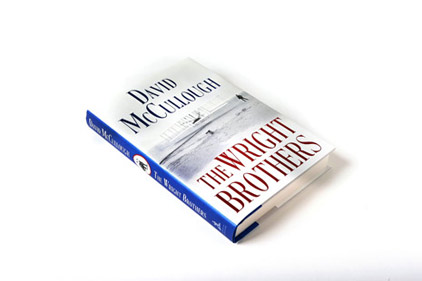 Speaking before the Aero Club of Washington, D.C., author David McCullough told more than 250 aviation alphabet-group representatives that he was pleased to be addressing an audience who knows the subject matter of his new book, The Wright Brothers, released in May. But McCullough—who researched his book for more than four years—shared many stories aboutaviation’s patriarchs that most had never heard.
Speaking before the Aero Club of Washington, D.C., author David McCullough told more than 250 aviation alphabet-group representatives that he was pleased to be addressing an audience who knows the subject matter of his new book, The Wright Brothers, released in May. But McCullough—who researched his book for more than four years—shared many stories aboutaviation’s patriarchs that most had never heard.
“What surprised me about writing about the Wright brothers was how much I didn’t know, and how little most of the country knows. They had a bicycle shop, lived in Ohio, and invented the airplane, period,” he said. “But Edith Wharton wrote that she had seen a Wright aeroplane in Paris and I was curious why a hick from Ohio was in France. Turns out nobody believed anything at the time unless it was in Paris; it was not until Le Mans that anyone believed the Wrights had invented the airplane. Until then they were crackpots, nuts.”
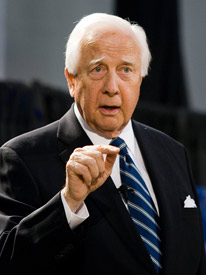 McCullough grew to deeply respect the two brothers as he read the more than 1,000 letters they wrote on various subjects, which are housed in the Library of Congress. “They are humbling to read,” he said. “The brothers were incapable of writing a short letter—or a boring one,” he said. He recalled the “extremely essential” influence of their sister Katherine, whom he said deserves long overdue credit; the insistence of their father for the brothers to read and have purpose; and their courage, both physical and intellectual. “They never married, never went on a vacation. They had a purpose,” he said. “After reading their letters—and even if they had failed—I would have wanted to write about them. There is a lot to learn from the Wright brothers. Adversity, they realized, was the lift you need in life to succeed.”
McCullough grew to deeply respect the two brothers as he read the more than 1,000 letters they wrote on various subjects, which are housed in the Library of Congress. “They are humbling to read,” he said. “The brothers were incapable of writing a short letter—or a boring one,” he said. He recalled the “extremely essential” influence of their sister Katherine, whom he said deserves long overdue credit; the insistence of their father for the brothers to read and have purpose; and their courage, both physical and intellectual. “They never married, never went on a vacation. They had a purpose,” he said. “After reading their letters—and even if they had failed—I would have wanted to write about them. There is a lot to learn from the Wright brothers. Adversity, they realized, was the lift you need in life to succeed.”
McCullough has written many historical novels; The Wright Brothers is his tenth book. Unlike many of his works, McCullough kept this book under 1,000 pages. But if even the 320-page book seems overwhelming, no worries—actor/producer Tom Hanks has purchased the rights to make the movie, much as he did with McCullough’s tome 1776.
Interview
Airplane built from cans powers hobbyist
Beverage cans may put pilot back into the air
By Alton K. Marsh
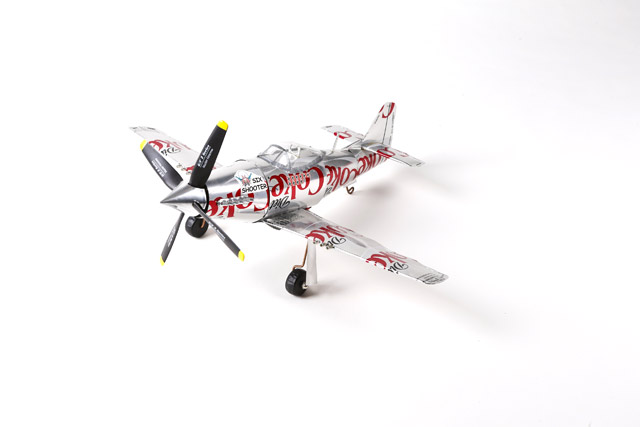
Can cans fly? Sure, if you throw them hard enough. Wayne Mathis of Helena, Montana, makes airplanes from beer and soda cans that really can fly. His customers who have purchased a set of his plans discovered if you add a model aircraft engine, they fly just like the real thing. B.C. (beverage can) Air Originals was started by Mathis, a retired printer with a pilot certificate, who offers plans for 53 models that cost $10 to $20.
How did you get started
I had built airplanes out of everything from twigs to cardboard, plastic, and paper since I was 5 years old. A friend knew this and asked if I could make an airplane out of a beer can.
How long have you been doing this?
Since 1984 I have offered plans for 53 designs, from $10 to $19.95, and have 1,500 squadron members. I call my customers squadron members. I have 10 grandkids and they all have one or more, depending on how often they visit.
Why do you do this?
If I sell enough airplanes I can return to flying. Also, I’m just plane nuts.
Email [email protected], web: www.bcairoriginals.com
Looking for a wider audience
Filmmakers want to bring ‘Flight of Passage’ to the big screen
By Jill W. Tallman
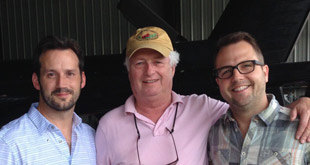
Filmmakers Henry Saine (left) and Colin Ebeling (right) want to make a full-length film of Rinker Buck’s Flight of Passage. Buck (center) told the story of how he and his brother flew coast to coast in a Piper PA–11 Cub Special as teenagers.
Two filmmakers want to bring Rinker Buck’s iconic Flight of Passage to the silver screen, and they have cleared the first hurdle by acquiring funding to make a short film that will be shown to investors.
Colin Ebeling and Henry Saine and their production company, Just Chorizo Productions, used the crowdfunding site Indiegogo to raise $36,370 to make a short film that they’ll pitch to investors, actors, and studios.
Buck’s memoir describes how he and his older brother Kernahan flew a Piper PA–11 Cub Special from New Jersey to California in 1966. At the time, they were 15 and 17 years old, respectively, and were the youngest pilots to make the cross-country trip.
Flight of Passage resonated with Ebeling, who read it while learning to fly in 2007. “Flight of Passage just basically spoke to everything I was experiencing in learning to how to fly. It was all of the adventure and excitement and also the discipline, and I just sparked to its message and everything it said about flying and life in general,” he said. Ebeling earned his private pilot certificate and flies out of Whiteman Airport in Los Angeles, California.
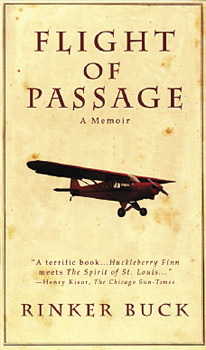 Much loved in the aviation community, Flight of Passage needs to be brought to a wider audience, Ebeling said. “Its appeal is much more universal. It’s a coming-of-age story [with] family relationships, brotherhood, adventure, and coming to terms with yourself and the hand you were dealt in life. It’s one of these wonderful pieces that didn’t quite break out…it deserves to. We want a larger audience to be a part of it and be able to experience [Buck’s] work.” Buck is profiled in the September 2015 AOPA Pilot (“Pilots: Flight of Passage Author”). His 2015 book, The Oregon Trail: A New American Journey, is on the New York Times bestseller list for hardcover nonfiction.
Much loved in the aviation community, Flight of Passage needs to be brought to a wider audience, Ebeling said. “Its appeal is much more universal. It’s a coming-of-age story [with] family relationships, brotherhood, adventure, and coming to terms with yourself and the hand you were dealt in life. It’s one of these wonderful pieces that didn’t quite break out…it deserves to. We want a larger audience to be a part of it and be able to experience [Buck’s] work.” Buck is profiled in the September 2015 AOPA Pilot (“Pilots: Flight of Passage Author”). His 2015 book, The Oregon Trail: A New American Journey, is on the New York Times bestseller list for hardcover nonfiction.
The full-length film could inspire a new generation “to see what flying’s all about, the adventure, the discipline, the camaraderie of pilots,” Ebeling said.
In the meantime, a short film is being produced because “pretty much the only thing that gets greenlit these days is existing, proven properties,” Ebeling said. That’s why you’re seeing mostly superhero films and sequels at local cinemas.
“It’s hard in Hollywood to get an agent or a film executive to sit down and read 105 pages of a feature-length script, but if you send them a link to a short film they instantly understand what the project is about, and they can see and hear and imagine how to market it,” Ebeling said. The short film will showcase some of the book’s best moments, including a flying sequence shot by Bill Richards, one of Hollywood’s aerial cinematographers. Filming was set to begin in October.
Just Chorizo Productions produced the 2013 action science-fiction thriller Bounty Killer in this fashion. “Within a week of putting [a short film] out, we had gotten the green light,” Eberling said.
Email [email protected]
Aviation History
Doc’s heartis beating again
One of the Seven Dwarf B–29 bombers returns to the skies
By Alton K. Marsh
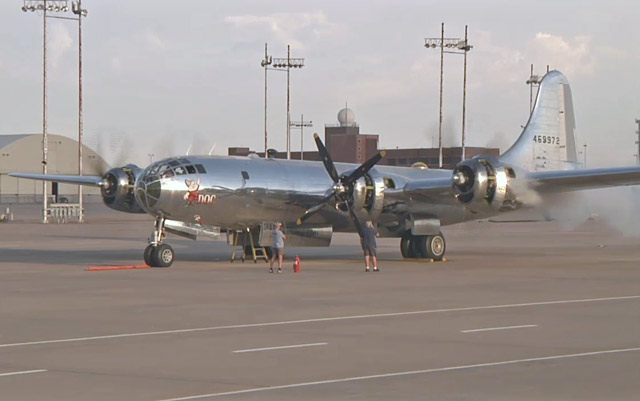
When it was over, T.J. Norman, supervisor of the restoration of Doc, the B–29 bomber in Wichita, leapt from the pilot’s seat and extended half his body through the window, applauding in the direction of the volunteers who put Doc back together again. Then he reached down to the cartoon drawing of one of Snow White’s favorite dwarfs and patted the head of Doc.
That pat was mostly for Doc’s willingness to start engine number two, the one hiccup in the first engine start for the bomber in many decades—nearly seven. Engine number two is inboard on the pilot’s side of the aircraft, the left side. The first engine start is a huge milestone toward the first flight, which the restoration team hopes will occur in October.
First,there are many more engine starts and tests at higher revolutions per minute. Engine number two will have to be looked at. It appears it was a sticky throttle-mixture lever that provided too much fuel during the start attempt, flooding it. Motoring, or turning the engine with the starter motor without ignition, was used to pump the excess fuel out of the engine. The start took place across from McConnell Air Force Base, which owns the runways Doc must use for first flight.
Actually making that first flight involves two steps. The FAA must approve an engine runup demonstration, and the Air Force must grant an exception to allow Doc to land after the first flight. At the moment the rules say that once Doc takes off, he’ll need to go somewhere else to land because returning to the Air Force base isn’t permitted.
Present in the co-pilot seat was Tony Mazzolini, who wrestled Doc away from the U.S. Navy (it wanted another warbird as a trade and he got it for them) and out of the California desert. It was a bombing target, last of a group of B–29s each named after one of the Seven Dwarfs. Another of that group is in an aviation museum in Arizona.
“Tony’s a kid again,” said Norman. “He’s 25 again.”
“All of the quality work paid off,” said 81-year-old Mazzolini.
Email [email protected]
Musings
2015 versus 1985
Back to ‘Back to the Future’
By Chip Wright
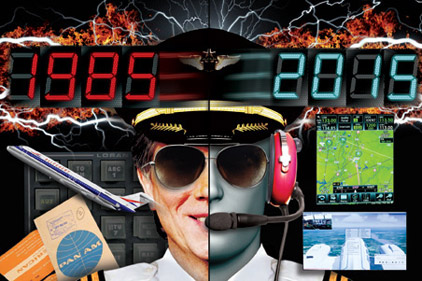 I write this as we enter the latter half of the year 2015. This is also the thirtieth anniversary of the hit movie Back to the Future, and 2015 is the year in the (then) future that characters Marty McFly and Doc Brown visit during the movie’s first sequel. I was a teenager when the movie came out in 1985, and the idea of a flying car was thrilling. To me, it romanticized the idea of flying—period. I hadn’t actually taken a flying lesson yet, and had been on only a handful of flights as a passenger—but movies like BTTF and Star Wars fed what was already an insatiable desire to fly, not just ride.
I write this as we enter the latter half of the year 2015. This is also the thirtieth anniversary of the hit movie Back to the Future, and 2015 is the year in the (then) future that characters Marty McFly and Doc Brown visit during the movie’s first sequel. I was a teenager when the movie came out in 1985, and the idea of a flying car was thrilling. To me, it romanticized the idea of flying—period. I hadn’t actually taken a flying lesson yet, and had been on only a handful of flights as a passenger—but movies like BTTF and Star Wars fed what was already an insatiable desire to fly, not just ride.
Looking back, it’s amazing to see just how much of aviation has changed—and how much is the same. In the mid-1980s, deregulation was still sorting the winners and the losers among the airlines. Industry stalwarts such as Eastern and Pan Am were on their last legs, Braniff was gone, and Southwest had barely left Texas. Back then, you bought tickets—actual, printed tickets, complete with actual carbon copies—from a travel agent or at an airport ticket counter, and you could transfer them from one individual to another. It also was common practice to call the airline the day before a flight to confirm your schedule and reservation, and you talked to a real person, in the United States. The hub-and-spoke system was widely in use but had not been as perfected as it is today.
The backbones of most domestic fleets were the Boeing 727, the Douglas DC–9, and early (and loud) Boeing 737s. Lockheed had just shut down the L–1011 line, but the DC–10 was still being built. The only twin-engine widebody at the time was Boeing’s 767.
In the general aviation world, Cessna was the heavy hitter, but the end of an era was approaching because, in 1986, it would stop building piston aircraft. Pipers, Mooneys, Lakes, and Beechcraft all still were in production. It was common to see twin-engine training at most flight schools, using Piper Apaches and the Beechcraft Duchess.
There probably is no greater example of the changes in aviation than the instrument panels. Gone are the days when an IFR airplane had an actual “six pack” of instruments. Further, there was little in the way of redundancy. If something broke, especially in instrument conditions, you needed to have a fair amount of proficiency in order to safely return to terra firma. Speaking of terra firma and cumulus granite, terrain awareness wasn’t provided by computer displays, but by the ability of the pilot to correctly interpret his or her charts, which were printed on actual paper. VOR to VOR using an OBS was standard fare for navigation, and NDBs were numerous enough that flying NDB approaches was considered fairly standard practice. Today we consider it a borderline emergency.
If you had the spare change, you could buy a long range navigation (loran) unit, which allowed for direct navigation before such was common. GPS was still a pie-in-the-sky dream for the private pilot, and glass screens and digital displays were strictly the purview of the airlines and the rich guys. That said, the dramatic drop-off in general aviation production capacity from the late 1980s into the 1990s allowed the Experimental world to thrive, and along with Experimental airplanes came experimental and high-tech avionics, eventually leading to the certification of many of the lightweight electronics we are so familiar with today. The automation in general aviation has, in many ways, surpassed what the airlines have. Where one door closed, another presented opportunity.
Training has evolved as well. Instead of a few nights a week in a traditional classroom environment to learn ground-school materials, most students can learn at home online at their own pace. Simulators and flight training devices are now available to a wide swath of pilots. In fact, we now have simulators and online training just for the electronics in the airplane, thanks to the complexity of modern systems.
The influence of the Experimental and the kit world that took off after the general aviation slump began is easily seen in the success of such companies as Cirrus, which began with a kit airplane. The Van’s line of kitplanes has become a model of success. Necessity does indeed become the mother of invention.
Today’s fleet, like today’s cars, consists of safety features and enhancements almost unheard of in 1985. Airbags, better seats, and whole-aircraft parachute systems proliferate today. VORs are more frequently reference points for GPS, and NDBs are all but gone. Roads? We still need those to get to the airport. But the Skyhawk and, recently, the Mooney lines are back, and where they’re going, they don’t need roads.
Chip Wright is an airline pilot and frequent contributor to AOPA publications.
Drone use will generate $82 billion and 100,000 jobs by 2025—Association for Unmanned Vehicle Systems International.


